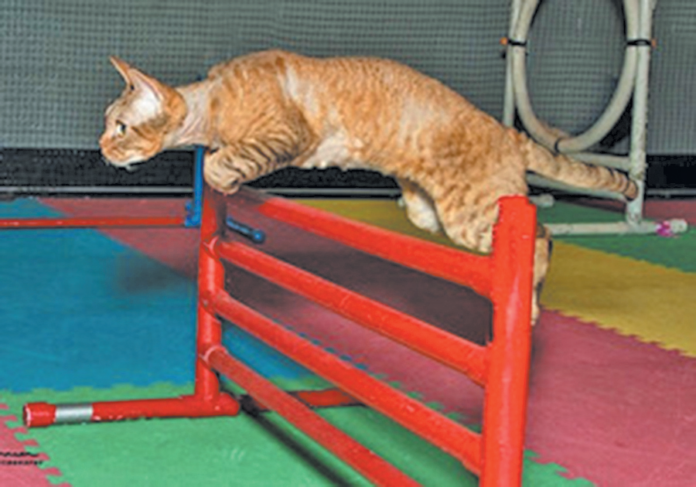We’ve all seen footage of dogs navigating agility courses — walking figure eights around cones, jumping over obstacles, flying through hoops, and cooperating with their owners in all kinds of other feats that require concentration as well as physical conditioning. Guess what? Cats can do it, too.
It’s easy enough to set up an agility course in your own home. Your cat may very well love it. After all, what else has she got to do? The best part: it’s easy to teach her, and you’ll both derive a lot of pleasure from agility games while improving your bond.
Getting started
You don’t have to spend a fortune setting up an agility course. In fact, it doesn’t even have to start with a whole course. You can begin simply by holding a hula hoop for your cat to go through or a small step stool to climb up and over. You can even make an A-frame climbing post by tilting two scratching posts toward each other, having them touch at the top. And for a tunnel, you can buy one of those collapsible nylon tunnels that toddlers enjoying crawling through or a long cardboard box that a vacuum cleaner or weed whacker came in.
Teaching your cat to comply
Your cat is probably more interested in cooperative play than you think. Many people train their pets to go through or over various obstacles with lures. A feather at the end of a stick waved in the cat’s line of vision, just out of reach at the far end of a tunnel, may be just the thing to get her to go through without hesitating. Strips of sparkly ribbon attached to a rod can also prove enticing. All that color, all that glitter, is hard for a cat to resist even if she might otherwise have trepidation about crawling through an unknown space.
Some people use clicker training to get cats to comply. Here’s one way to get started. Set out an obstacle you want your pet to negotiate successfully. When she happens to (choose one) climb the small step ladder, go through the hoop, or jump over the hurdle, immediately press a clicker and offer her a morsel of a food she finds delectable. Before long, you can add a word to the routine, like “climb” or “jump.” That way, she learns that if she follows through on a cue from you rather than just coincidentally makes a certain move, she will get a click and a treat.
It takes patience — and not a hint of disappointment or frustration from you when she doesn’t follow through. Even subtle negative reactions like that will shut a cat down. But over time, you will learn just how cooperative your cat can be and how much she enjoys collaborating with you on various tricks. It will enrich your life as well as hers.
Ramping it up
Once your cat starts to get the hang of being rewarded for a job well done, you and she can graduate from one piece of utility equipment to a whole course — hoops, weave poles, tunnels, steps, and climbing structures. It will be a lot more fun for her than just sleeping, self-grooming, and getting fed and petted a couple of times a day.
And if the two of you get really into it, you can enter her in cat agility competitions.
The Cat Fanciers’ Association puts on feline agility shows around the world, and they’re open to any cat. Your feline companion doesn’t have to have a pedigree or certain look.
Such shows have very specific set-ups for the different equipment. Each hurdle must have so many bars that are so many inches off the ground; each hoop must have a specific diameter; each weave pole must be so many feet apart. But if you and your cat have been practicing at home, she’ll be able to get the hang of it.
For more information, head to cfa.org, type “agility” into the search bar, and scroll down until you see the word “agility” by itself. You’ll find information on how to train your cat, schedules for when and where competitions occur, even how to become an agility ringmaster.
Check out the site’s videos showing cat agility in action, too. They provide good motivation. If those cats can do it, so can yours.





This article is fantastic! And it’s just what my Lexie needs! I can’t wait to start agility training with her!
Thank for you for writing about cat agility!
I like the DYI options. We use two pet stairs with a board across for a pet walk.
Unfortunately, CFA doesn’t offer any agility competitions in our state. We’ll have to be content doing it in our basement and posting videos to YouTube.
My cats (including a former feral) and I have been doing it for years. They regularly coax for their agility time.